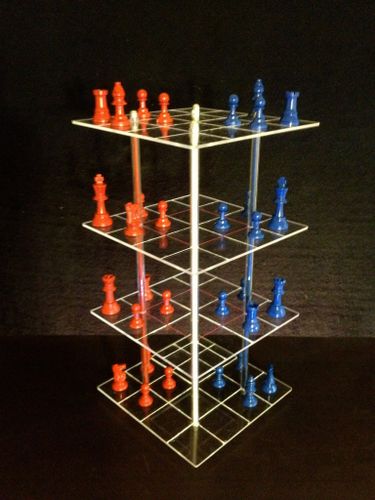|
Advertisement
|
3D XYZ Chess

Description3D XYZ Chess is played on four levels, with 4x4 spaces each, effectively a 4x4x4 array of cubes. The game thus contains 64 spaces, or cubes, the same number as a regular Chess board. Moreover, each player controls a 16-piece army that is identical to the regular Chess army, albeit with some altered powers. The board is placed with vertical corners (rather than sides) facing each player, and the pieces are positioned initially in these opposite vertical corners. The Rook moves in a straight line through cubes that are connected via their sides; the Bishop moves in a straight line through cubes that are connected via their edges; the Queen combines the powers of Rook and Bishop. Effectively, these pieces retain their regular Chess moves, with the proviso that they can travel also in vertical planes. The Knight has a different and entirely new move that does not correspond to anything in regular Chess—the Knight moves one cube triagonally, in other words between cubes that are connected at their corners. The King's move is constrained, and the King can move only one square orthogonally, not diagonally, both within his plane and vertically. The Pawns step one space (or two spaces initially) towards the opposite corner, and cannot move vertically. Pawns capture as they move, like the other pieces, and unlike Chess Pawns. The triagonal move of the Knights is interesting, because a Knight can only reach 16 spaces, one quarter of the board. The Knights of one side together cover only half the board. One could regard this as a flaw, but I do not think it is—there is a pleasing symmetry due to the opening placement of the four Knights of both sides. The two sets of Knights do not cover each other's squares, so opposite-side Knights can never capture each other, and together the Knights of both sides cover all spaces on the board. I am sure this special move of the Knight has interesting strategic implications. Game DiscussionsAdd CommentYou need to be logged in to comment. Insert Bullet List Please enter at least one item. Item: Item: Item: Item: Item: Insert Numeric List Please enter at least one item. Item: Item: Item: Item: Item: Insert Link Please enter the link of the website Optionally you can add display text Insert Email Please enter the email address Optionally add any display text Insert Image Please enter the link of the image Insert YouTube Video Please enter the link of the video Marketplace | ||||

Comments (0)